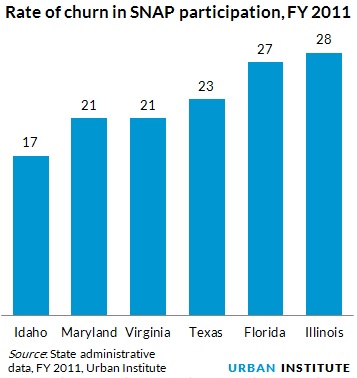
The Supplemental Nutrition Assistance Program (SNAP, formerly food stamps) is effective at improving the food security of low-income households and providing some stability in their lives—that is, until they lose benefits because of an administrative hassle and have to reapply. This on-again, off-again scenario is a very real problem for the program. The USDA calls it “churning,” where SNAP participants exit the program and then re-enter it within four months.
How common is churn among SNAP recipients, what causes it, and how much does it cost participants and agencies? The Urban Institute just completed a three-year USDA-funded study to answer those questions. Researchers conducted extensive data analysis and field research in six states: Florida, Idaho, Illinois, Maryland, Texas, and Virginia.
Here are some key findings:
- Rates: The estimated rates of churn for the six participating states ranged from 17 to 28 percent in fiscal year 2011, as shown in the figure. This is the percentage of households receiving SNAP that experienced at least one churn spell that began and/or ended within the year.
- Causes: The causes of churn are complex. Some churn is natural. Earnings fluctuations appear to play a limited role, and are more relevant among churn spells of more than one month. In these instances, a household member may get a job and no longer qualify for benefits, but then may quickly lose that job, prompting a reapplication and reapproval of benefits. The much larger story is about procedural difficulties that come up during recertification, when most churn occurs. Sometimes recertification notices have been sent to the wrong address, so recipients miss the notice and their SNAP benefits are cut off. Other times, recipients failed to respond to notifications because they were struggling with personal problems, could not read or understand the notice, or were unable to respond online or in person.
- Cost for participants: The annual amount of forgone SNAP benefits due to churn ranges—in the study—from $2.2 million in Idaho to $108.2 million in Florida. SNAP recipients reported experiencing a great deal of anxiety when they lost their benefits, even for a short period of time. Participants typically live on very tight budgets, so losing benefits can not only lead to hunger and food insecurity, but may also lead to missed rent or utility payments as recipients shift scant resources away from other bills to buy food.
- Cost for agencies: Reapplications for SNAP households returning to the program take up more staff time than recertifications. The costs of churn make up about 1 to 4 percent of overall administrative costs. Based on the number of instances of churn, annual statewide churn costs can range from $100,000 in Idaho to $6 million in Illinois. While this cost is small in proportional terms, even a small amount is still wasteful.
To reduce churn, federal, state, and local agencies should carefully look for opportunities to lessen the administrative burden on SNAP recipients, for example by improving mailings and notifications and allowing longer certification periods, higher thresholds for updates, and electronic signatures so participants don’t have to recertify in person.
Tune in and subscribe today.
The Urban Institute podcast, Evidence in Action, inspires changemakers to lead with evidence and act with equity. Cohosted by Urban President Sarah Rosen Wartell and Executive Vice President Kimberlyn Leary, every episode features in-depth discussions with experts and leaders on topics ranging from how to advance equity, to designing innovative solutions that achieve community impact, to what it means to practice evidence-based leadership.
